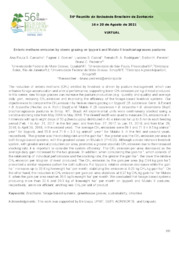Enteric methane emission by steers grazing on Ipyporã and Mulato II brachiariagrasses pastures.
Enteric methane emission by steers grazing on Ipyporã and Mulato II brachiariagrasses pastures.
Author(s): CARVALHO, A. P. da S.; GOMES, F. J.; CABRAL, L. S.; RODRIGUES, R. de A. R.; PEREIRA, D. H.; PEDREIRA, B. C. e
Summary: The reduction of enteric methane (CH4) emitted by livestock is driven by pasture management, which can enhance forage accumulation and animal performance, supporting lower CH4 emission per kg of meat produced. In this sense, new forage grasses can increase the pasture production (e.g.; quantity and quality) and average daily gain, reducing CH4 emission and improving the efficiency of the forage-based livestock systems. Our objective was to compare the CH4 emission by Nellore steers grazing on ?Ipyporã? [B. ruziziensis Germ. & Evrard × B. brizantha (Hochst. ex A. Rich.) Stapf] and ?Mulato II? (B. ruziziensis × B. brizantha × B. decumbens Stapf) brachiariagrasses pastures in Sinop, MT, Brazil. All experimental units were continuously stocked using a variable stocking rate from May 2016 to May 2018. The GreenFeed® was used to measure CH4 emissions at 4- h intervals with up to eight drops of 50 g (feed supply) distributed in 40-s intervals for up to 5 min in each feeding period (Feb. 1 to Apr. 31, 2017, in the first year; and from Nov. 27, 2017, to Jan. 11, 2018, and from Mar. 29, 2018, to April 30, 2018, in the second year). The average CH4 emissions were 59.1 and 71.9 ± 9.5 kg animal-1 year-1 for Ipyporã, and 55.8 and 71.9 ± 3.2 kg animal-1 year-1 for Mulato II, in the first and second years, respectively. The greater was the stocking rate and the gain ha-1, the greater was the CH4 emission per area in both forage-based systems, with the greatest values on Mulato II (P<0.05). Although a more intensive livestock system, with greater animal production per area, promotes a greater absolute CH4 emission due to the increased stocking rate, it is important to consider the system efficiency. The CH4 emission per area decreased as the average daily gain increased for the two grasses. In addition, when considering the gain ha-1, which consists of the relationship of individual performance and the stocking rate, the greater the gain ha-1, the lower the relative CH4 emission per kilogram of meat produced. The CH4 emission by the gain per area (kg CH4.kg gain ha-1) presented a similar response pattern for both cultivars. For Ipyporã, relative emission decreases while the gain ha-1 increases up to 33.6 kg liveweight ha-1 per month, stabilizing the emission at 0.25 kg CH4.kg gain ha-1. On the other hand, the reduction in CH4 emission per gain per area stabilizes at 0.27 kg CH4.kg gain ha-1 for Mulato II, when the gain per area reaches 20.6 kg liveweight ha-1 per month. We concluded that forage-based systems producing more than 33.6 and 20.6 kg of liveweight ha-1 per month on Ipyporã and Mulato II pastures, respectively, are more efficient, emitting less CH4 per unit of product.
Publication year: 2021
Types of publication: Abstract in annals or event proceedings
Unit: Embrapa Soils
Keywords: Brachiaria, Brachiaria Brizantha, Brachiaria Decumbens, Brachiaria Ruziziensis, Capim Urochloa, Efeito Estufa, Emissão de metano, Environmental sustainability, Forage, Forage grasses, Forage production, Forragem, Gado Nelore, Grasses, GreenFeed, Greenhouses, Ipyporã, Lavoura-pecuária, Metano, Methane, Mulato ii, Nellore, Pastagem, Urochloa
Observation
Some of Embrapa's publications are published as ePub files. To read them, use or download one of the following free software options to your computer or mobile device. Android: Google Play Books; IOS: iBooks; Windows and Linux: Calibre.
Access other publications
Access the Agricultural Research Database (BDPA) to consult Embrapa's full library collection and records.
Visit Embrapa Bookstore to purchase books and other publications sold by Embrapa.

